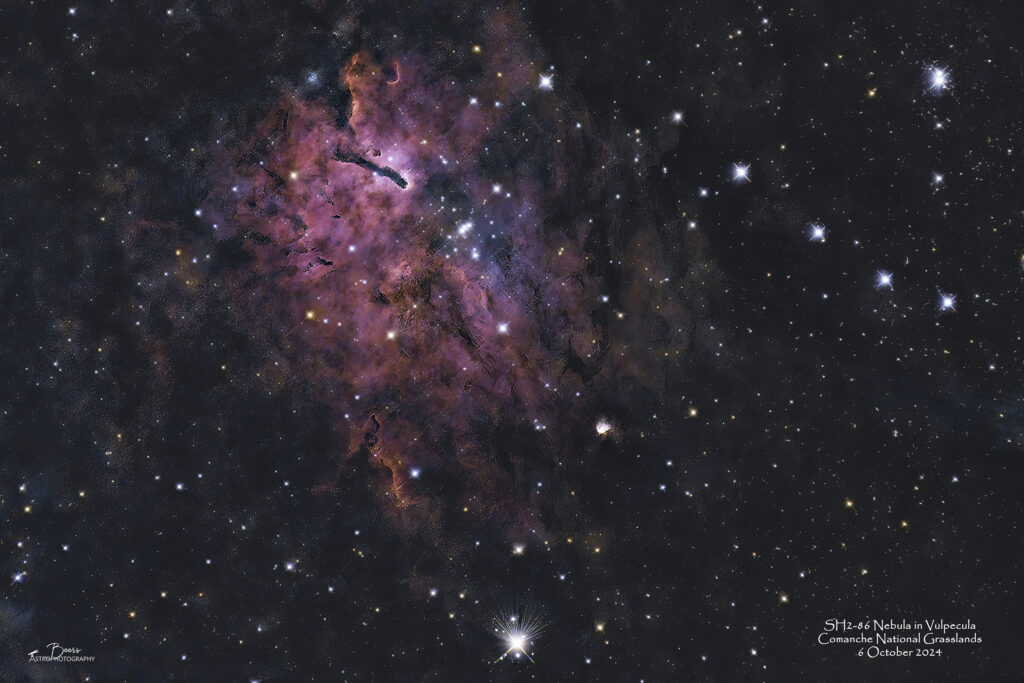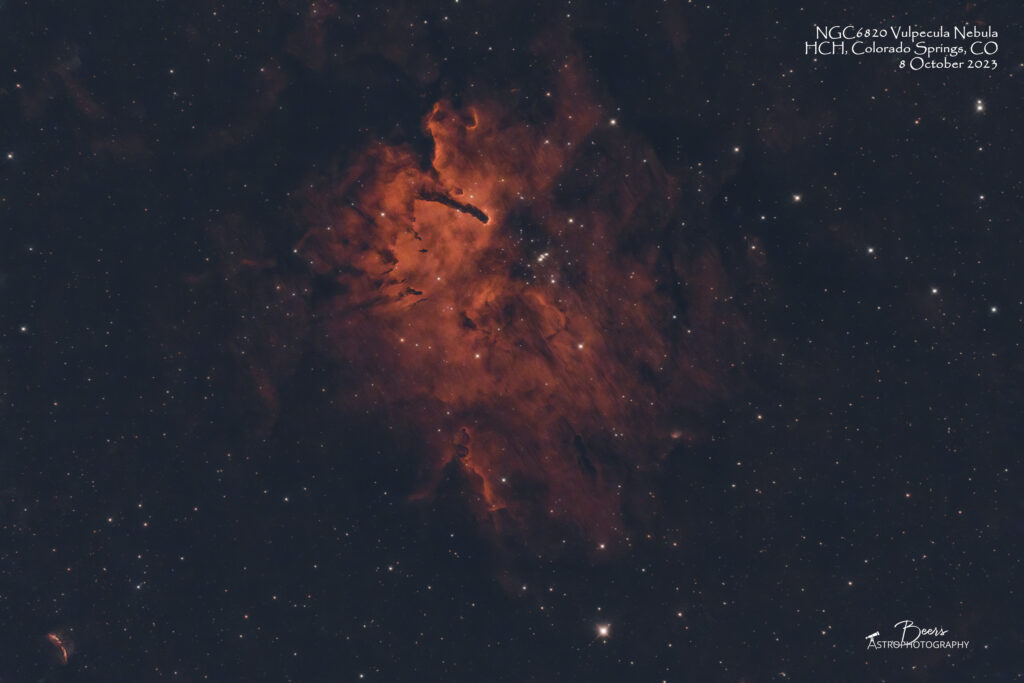
Fun facts
NGC 6820 is a small reflection nebula near the open cluster NGC 6823 in Vulpecula. The reflection nebula and cluster are embedded in a large faint emission nebula called Sh 2-86. The whole area of nebulosity is often referred to as NGC 6820.
M27, the Dumbbell Nebula, is found three degrees to the east, and α Vulpeculae three degrees to the west.
Open star cluster NGC 6823 is about 50 light-years across and lies about 6,000 light-years away. The center of the cluster formed about two million years ago and is dominated in brightness by a host of bright young blue stars. Outer parts of the cluster contain even younger stars. It forms the core of the Vulpecula OB1 stellar association.
Type: Emission Nebula (NGC6820) with Open Cluster (NGC6823)
Distance: 6000 light years
Apparent dimensions: 40’ x 30’
Magnitude : 7.10
Radius: 50 light year (diameter of NGC6823)
Constellation: Vulpecula
Designations: Nebula (NGC6820, SH2-86), Star Cluster (NGC6823), LBN135, Cr405
{Target information from https://en.wikipedia.org/wiki/NGC_6820_and_NGC_6823 and Stellarium}
Capture & Processing Notes
SH2-86 Vulpecula Nebula was the first target for Big Bertha on our second night at the Comanche National Grasslands Camel Rock camping site during our October dark skies trip.
The second night of imaging during our October 2024 dark skies trip to Comanche National Grasslands was much calmer, both wind-wise and being prepared to start imaging. On Sunday morning, in going through the power issues I had with Paul (the real/practical electrical engineer in the family), he told me how sensitive DC is to slight perturbations. The wind or not inserting and turning the cigarette lighter connection to make sure it is secure could have been the root cause of my issues on Saturday night. So I made sure to do that for Sunday night’s imaging (of course, there was no wind). I still had the repeat of the BB comm port glitch upon switching from polar alignment to SGP imaging at the beginning of the evening…but it took me much less time to diagnose and resolve than it had on the first night of imaging.
I discovered when I polar aligned the equipment on the second night, that both rigs were out of alignment more than the settling overnight would account for – so I corrected that issue during the polar alignment process on Sunday night. Low and behold, the autoguider performance (and resulting images) was MUCH better throughout the night.
I didn’t connect the autofocuser to Big Bertha on the first night because I didn’t have the courage to work with all the small screws, nuts, bolts to attach it in the dark. I did connect it during the day on Sunday to use it during Sunday night’s imaging. But, I’d forgotten to bring BB’s new rack and pinion focuser, so I was using the original Orion Crayford focuser. The EAF focusing shaft knob was connected to the EAF, so I just installed the bracket and attached it to BB’s focuser’s shaft. When I did that, I noticed that the knob was just barely contacting BB’s focuser’s shaft, but at the time I didn’t think I had any way to test it (actually I didn’t want to take the time/energy). I could/should have set up the laptop to test it in the daylight. Because when I started the sequence with the EAF in the stream, it was barely moving the focuser (even though I had SGP set for a step size of 175). At that point…in the dark…I took a closer look at the connection between the knob and BB’s focuser’s shaft and realized I should have moved the knob away from the EAF end to get more “bite” onto the shaft. At that time it would have required taking the entire bracket assembly apart and off of BB…in the dark…so I opted not to use the EAF for the second night of imaging either. As an aside, as I’m typing this journal (two weeks later) it occurred to me that the other issue might have been that I had the wrong EAF knob attached. I must verify the next time I set up BB, but I’m thinking that knob may have been the (bigger) one that I need to attach to the rack & pinion focuser’s shaft.
After changing out the sequence profile to the BB with no EAF profile, doing a manual focus with the Bahtinov lens, I got the sequence started by 2018MDT and it ran flawlessly until it was time to switch to the night’s second target at 00:45MDT.
Sequence Plan (6Oct2024): Gain: 158, Temp: -0°C, offset=30. 51x300sec. Total: 255 minutes (4:15hrs). Captured 6Oct2024, 20:18MDT – 7Oct2024, 00:43MDT.
Processing: Captured in SGP, stacked in APP (Adaptive Airy Disc), star removal with Starnet++, processing with LR/PS
Equipment
All equipment controlled by HP Probook running Sequence Generator Pro v4.4.1.1441.
- Autoguiding: Orion 60mm Multi-Use Guide Scope with Orion StarShoot AutoGuider Pro Mono Astrophotography Camera (controlled by PHD2)
- Imaging (ASI2400-BB-FF): ZWO ASI2400MC imaging camera on (Big Bertha) Orion 8″ f/8 Ritchey-Chretien Astrograph Telescope. Removed the FF after the first target of the first night due to its causing excessive coma throughout the star field (Teleskop Service Flattener 1.0x for RC Telescopes (TS-RCFLAT2))
- Autofocuser: ZWO EAF Electronic Automatic Focuser (EAF-5V-STD). (Assembled the autofocuser, but it was not making enough contact with the focuser knob to operate properly, did without through the night.)
- Mount: Rainbow Astro RST-300 (controlled by iHubo ASCOM driver)
- Polar alignment: QHYCCD camera (controlled by Polemaster for polar alignment)
Summary
Capture: 6 October 2024; Total data capture: 4:15 hours
Shooting location: Comanche National Grasslands’ Camel Rock, Colorado
Equipment: Big Bertha (on RST-300 mount)
Processing: Captured in SGP, stacked in APP (Adaptive Airy Disc), star removal with Starnet++, processing with LR/PS
Other images of the Vulpecula nebulous region
Captured in the city lights from the HCH Front Patio

Capture & Processing Notes
This image was captured on Sunday night, 8 October 2023 during a streak of clear nights leading up to our departure on Thursday (12Oct2023) to image the annular solar eclipse. Since, I’d recently (the day before!) figured out the field flattener and we were only going to take the Southern Cross to Los Alamos, I decided to spend my time imaging from the front patio as much as possible with Big Bertha.
This object is not officially named the Vulpecula Nebula – in all sources, it is simply NGC6820. I decided it needed a name, since it’s in the Vulpecula constellation, I got creative and chose Vulpecula Nebula ;-}. But…after processing it, I’m seeing all sorts of “things” in the image – reminiscent of the days when we were kids, laying on our backs, looking up at the clouds, and naming what we saw. Can you see a pig’s face (snout and mouth), a puppy with big dark eyes, and a donkey? Perhaps it should be the Barnyard Nebula instead?? (I have NOT been drinking! Sleep deprived, well yes.)
Equipment
Polar alignment: QHYCCD camera (controlled by Polemaster)
Imaging stream: (Big Bertha) Orion 8″ f/8 Ritchey-Chretien Astrograph Telescope, ZWO ASI2400MC imaging camera, Teleskop Services TS-Optics 2″ 1.0x Flattener and Field Corrector for Ritchey-Chrétien Telescopes (TS-RCFLAT2), 89.7mm of connector tubes between camera and TS-RCFLAT2 for proper backfocus (M54M-M48F 21L, 2” M48F, M48F 16.5L), Optolong LeXtreme light pollution filter
Mount: SkyWatcher EQ6‑R PRO Synscan mount (controlled by ASCOM driver)
Autoguider: Orion 60mm Multi-Use Guide Scope, Orion StarShoot AutoGuider Pro Mono Astrophotography Camera (controlled by PHD2)
All equipment controlled by HP Probook (DSO CTRL 2) Windows 11 laptop running Sequence Generator Pro v4.2.0.16.
Summary
Sequence plan: Gain: 158, Temp: -0°C, offset=30; 50x5min; captured
Capture: 8 October 2023 (8Oct23, 2034 – 9Oct23, 0053MDT); Total exposure time: 4:20hrs.
Shooting location: HCH, Colorado Springs, CO
Processing summary: Captured with SGP. Stacked in APP. Star removal with Starnet++. Processed in LR/PS
